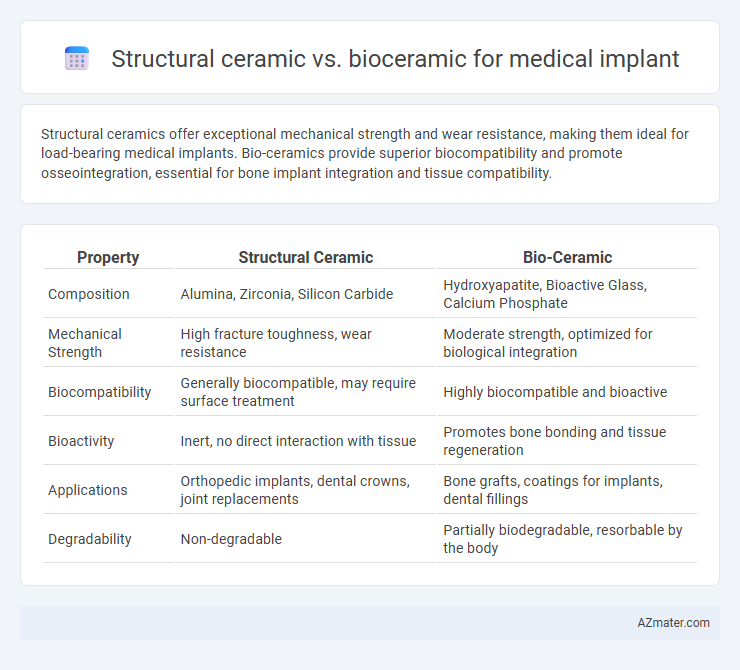Structural ceramics offer exceptional mechanical strength and wear resistance, making them ideal for load-bearing medical implants. Bio-ceramics provide superior biocompatibility and promote osseointegration, essential for bone implant integration and tissue compatibility.
Table of Comparison
| Property | Structural Ceramic | Bio-Ceramic |
|---|---|---|
| Composition | Alumina, Zirconia, Silicon Carbide | Hydroxyapatite, Bioactive Glass, Calcium Phosphate |
| Mechanical Strength | High fracture toughness, wear resistance | Moderate strength, optimized for biological integration |
| Biocompatibility | Generally biocompatible, may require surface treatment | Highly biocompatible and bioactive |
| Bioactivity | Inert, no direct interaction with tissue | Promotes bone bonding and tissue regeneration |
| Applications | Orthopedic implants, dental crowns, joint replacements | Bone grafts, coatings for implants, dental fillings |
| Degradability | Non-degradable | Partially biodegradable, resorbable by the body |
Introduction to Ceramics in Medical Implants
Structural ceramics and bio-ceramics are critical materials in medical implants, offering exceptional hardness, wear resistance, and biocompatibility. Structural ceramics, such as alumina and zirconia, provide high strength and fracture toughness suitable for load-bearing applications like joint replacements and dental implants. Bio-ceramics, including hydroxyapatite and bioactive glass, promote osseointegration and bone regeneration, making them ideal for coatings and bone grafts in orthopedic and dental surgeries.
Defining Structural Ceramics
Structural ceramics are advanced materials characterized by high mechanical strength, wear resistance, and thermal stability, making them ideal for load-bearing medical implants such as hip joints and dental prosthetics. These ceramics typically include alumina, zirconia, and silicon nitride, which exhibit excellent fracture toughness and biocompatibility to withstand physiological stresses. In contrast, bio-ceramics focus more on biological interaction, promoting osseointegration and tissue compatibility, often used for coatings or bone graft substitutes rather than primary structural components.
What are Bio-ceramics?
Bio-ceramics are specialized ceramic materials designed for medical implants that interact safely with biological tissues, offering excellent biocompatibility and bioactivity. These materials, such as hydroxyapatite and zirconia, promote bone integration and minimize inflammatory responses, making them ideal for orthopedic and dental implants. Unlike structural ceramics, which primarily provide mechanical strength and wear resistance, bio-ceramics actively participate in biological processes to support tissue regeneration and healing.
Key Material Properties: Structural vs. Bio-ceramics
Structural ceramics for medical implants exhibit exceptional mechanical strength, high wear resistance, and fracture toughness, making them ideal for load-bearing applications such as orthopedic joint replacements. Bio-ceramics, including bioactive glass and hydroxyapatite, demonstrate superior biocompatibility, osteoconductivity, and integration with bone tissue, which promotes bone growth and healing. Key differences in thermal expansion, chemical stability, and porosity dictate the selection of structural ceramics for durability, while bio-ceramics are chosen for their biological interaction and resorbable properties in regenerative medicine.
Biocompatibility and Tissue Integration
Structural ceramics like alumina and zirconia offer high strength and wear resistance but may have limited bioactivity, potentially reducing direct tissue integration. Bio-ceramics such as hydroxyapatite and bioactive glass promote superior biocompatibility by actively bonding with bone tissue, enhancing osseointegration and reducing implant rejection risk. Optimizing implant success relies on balancing the mechanical stability of structural ceramics with the bioactive surface properties of bio-ceramics to achieve effective tissue integration.
Mechanical Strength and Durability Comparison
Structural ceramics such as alumina and zirconia exhibit superior mechanical strength and fracture toughness, making them highly durable under high-stress conditions in medical implants. Bio-ceramics, including hydroxyapatite, offer excellent biocompatibility and osseointegration but generally have lower mechanical strength and are more prone to wear and fracture over time. The choice between structural ceramics and bio-ceramics depends on the implant application, balancing the need for mechanical durability versus biological performance.
Common Applications in Medical Implants
Structural ceramics such as alumina and zirconia are widely used in load-bearing medical implants like hip and knee joint replacements due to their high strength, wear resistance, and biocompatibility. Bio-ceramics, including hydroxyapatite and bioglass, are primarily utilized for bone grafts, coatings on metallic implants, and dental applications because of their excellent bioactivity and ability to promote bone growth. Common applications highlight structural ceramics in joint prostheses and dental crowns, while bio-ceramics are favored for bone regeneration and surface modification to enhance osseointegration.
Clinical Performance: Success Rates and Limitations
Structural ceramics, such as alumina and zirconia, demonstrate high success rates in orthopedic implants due to their exceptional mechanical strength and wear resistance, resulting in low failure rates over long-term use. Bio-ceramics like hydroxyapatite offer superior bioactivity and osseointegration, enhancing bone bonding but often exhibit lower mechanical durability under load-bearing conditions. Clinical limitations of structural ceramics include brittleness and risk of fracture, while bio-ceramics may suffer from degradation or resorption, affecting implant longevity and reliability.
Innovations and Future Trends in Ceramic Implants
Structural ceramics in medical implants exhibit exceptional strength and wear resistance, ideal for load-bearing applications like orthopedic joint replacements. Bio-ceramics focus on biocompatibility and osteointegration, using materials such as hydroxyapatite to promote bone growth and reduce immune response. Emerging trends emphasize nanostructured ceramics and 3D printing technologies to create personalized implants with enhanced durability and biological performance.
Conclusion: Choosing the Right Ceramic for Medical Implants
Structural ceramics offer exceptional toughness and wear resistance, making them ideal for load-bearing medical implants such as hip and knee replacements. Bio-ceramics excel in biocompatibility and bioactivity, promoting bone integration and reducing immune response, which is crucial for dental implants and bone grafts. Selecting the right ceramic depends on the specific application requirements, balancing mechanical strength with biological interaction to ensure implant longevity and patient safety.

Infographic: Structural ceramic vs Bio-ceramic for Medical implant
 azmater.com
azmater.com